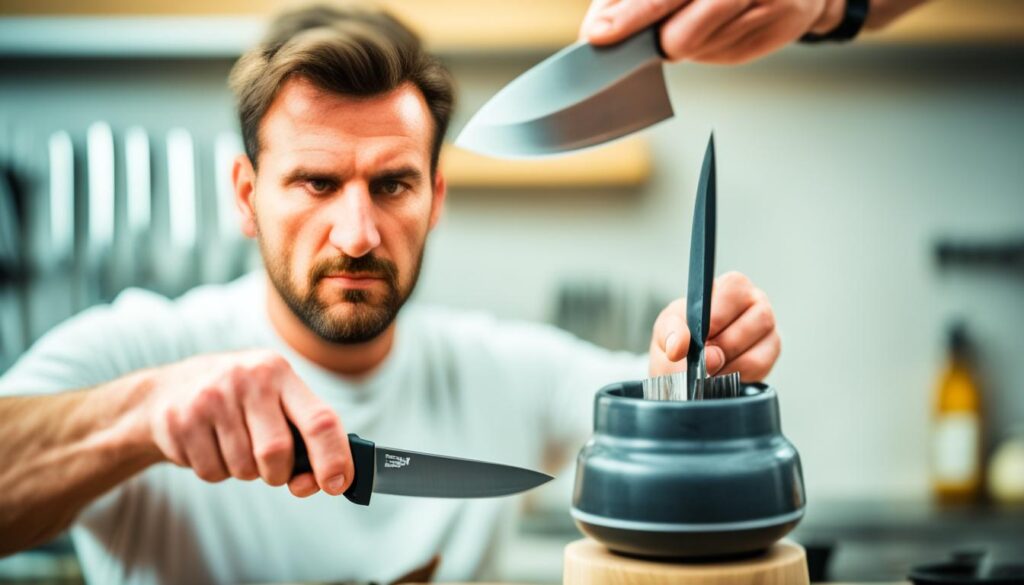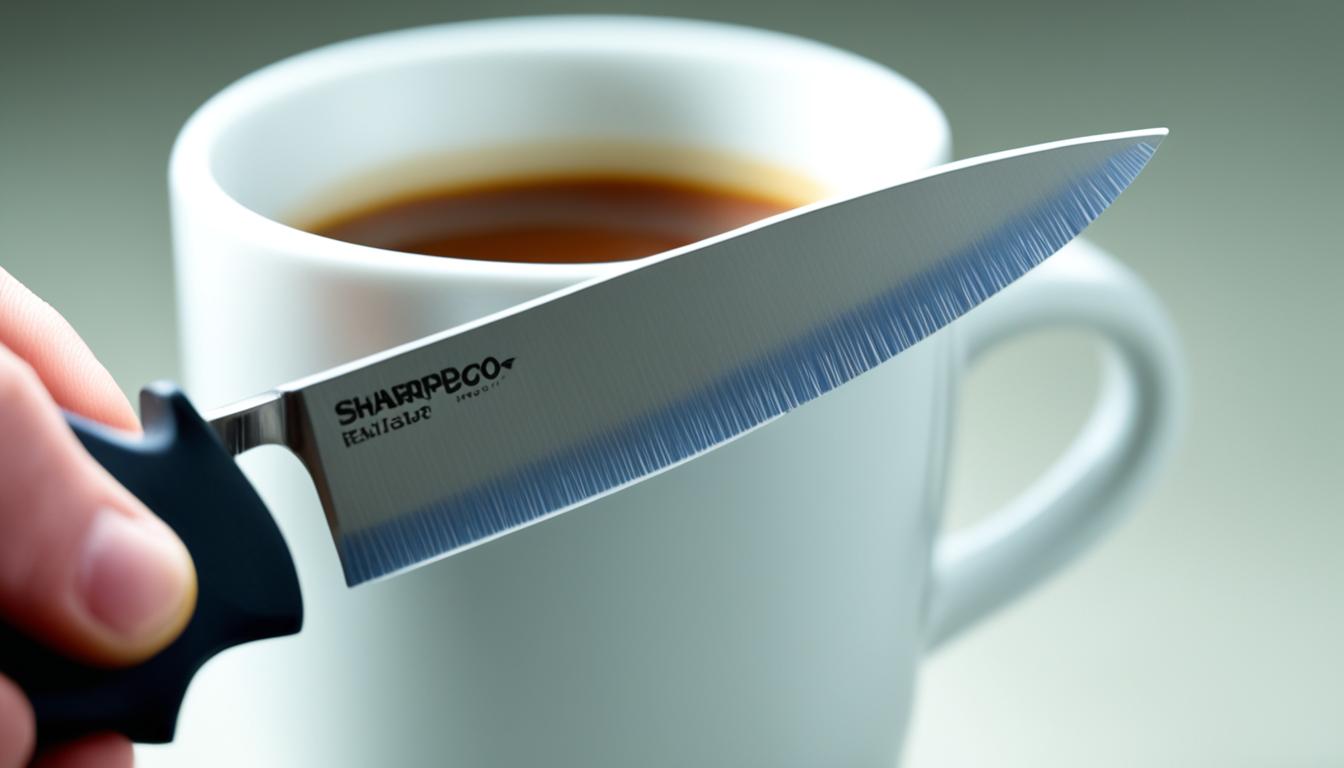Have you ever found yourself with a dull knife and no sharpener in sight? Well, there’s a simple trick you can try using just a ceramic mug. This method has been shared by various sources and is a quick and effective way to sharpen your kitchen knives. But is it really possible to sharpen a knife on a mug? Let’s find out!
How to Sharpen a Knife on a Mug
In order to sharpen your knife using a mug, you’ll need a ceramic mug with an unglazed rim. Here is a step-by-step guide on how to successfully sharpen your knife on a mug:
- Start by flipping the mug upside down and holding it firmly in your hand.
- Place the knife blade at a 15 to 20-degree angle against the exposed ceramic rim at the bottom of the mug.
- Run the knife blade along the rim, applying even pressure, and repeat the motion several times on each side of the blade.
- This technique removes material from the knife blade and creates a new, sharper edge.
It’s important to choose a sturdy mug for this method, as delicate or expensive china may not provide the necessary stability. This technique is particularly useful for cheap knives or in emergency situations when a dedicated sharpening stone is not available.
Remember to exercise caution while sharpening your knife and always maintain proper angles and pressure. With a ceramic mug and a steady hand, you can sharpen your knife and restore its effectiveness in no time.
Benefits of Using a Mug for Knife Sharpening
Using a ceramic mug for knife sharpening offers several benefits. First, it is a convenient and accessible method, as most households have a ceramic mug in their kitchen. It can be a quick and effective way to sharpen dull knives, saving you time and effort.
Additionally, this technique is relatively easy to master, even for beginners. It provides a temporary solution for maintaining the sharpness of your knives until you can use a dedicated sharpening tool. The unglazed ceramic rim of the mug acts as a sharpening surface, removing material from the blade and creating a new edge.
Tips for Sharpening Knives on a Mug
When it comes to sharpening your knife on a mug, there are a few tips that can help you achieve the best results. We want to share our expertise to ensure your sharpening technique is on point. Follow these simple guidelines:
- Maintain a consistent angle: To achieve a symmetrical and sharp edge, it’s crucial to maintain a consistent angle of about 15 to 20 degrees while running the blade along the ceramic rim. This ensures an even sharpening process and prevents the blade from becoming uneven.
- Gradually refine the edge: Start by using a higher number of strokes on each side of the blade, gradually decreasing the number as you refine the edge. This technique allows you to achieve a centered edge that can grip ingredients effectively, enhancing your cutting experience.
- Choose a sturdy mug: When selecting a mug for knife sharpening, opt for one with a sturdy handle that provides a firm grip. Avoid using mugs with delicate or decorative handles, as they may not offer the required stability for effective sharpening. A well-gripped mug ensures safety and precision during the sharpening process.
By following these tips, you can effectively sharpen your knives on a mug and maintain their sharpness for optimal performance.
Alternatives to Mug Sharpening
While mug sharpening is a convenient method, there are alternatives available if you don’t have a ceramic mug at hand. Here are some substitutes you can try:
- Top edge of a rolled-down car window: Similar to the ceramic mug’s unglazed rim, the top edge of a rolled-down car window can serve as a substitute sharpening surface. Simply run the knife blade along the edge at a consistent angle, applying even pressure.
- Smooth stone or slab of concrete: In a pinch, you can also use a smooth stone or slab of concrete found outside. These surfaces can provide a makeshift sharpening surface when no other options are available. However, keep in mind that they may not offer the same level of precision as a dedicated sharpening tool or a ceramic mug.
Precautions and Considerations
While using a mug to sharpen your knives is a useful technique, there are a few precautions and considerations to keep in mind.
- First, be aware that this method removes more material from the blade compared to a dedicated sharpening stone. Therefore, it is recommended to use this technique only with cheap knives or in emergency situations. Using it repeatedly can cause the blade to shrink.
- Additionally, choose your mug carefully and avoid using your finest china, as the sharpening process may leave a dark residue of shaved metal on the mug, which can easily be washed off.

Importance of Sharp Knives in the Kitchen
Maintaining sharp knives in the kitchen is essential for efficient and safe cooking. Dull knives require more force to cut through ingredients, increasing the risk of accidents and injuries. Sharp knives, on the other hand, allow for precise and controlled cutting, making your cooking experience smoother and safer. Proper knife skills combined with sharp blades can enhance your culinary abilities and help you achieve professional results in the kitchen.
Why sharp knives matter
- Efficiency: When you have sharp knives, you can effortlessly glide through ingredients, saving time and energy in the kitchen.
- Precision: Sharp knives allow for precise cuts, ensuring consistency in the size and shape of your ingredients.
- Safety: Dull knives require more pressure to cut, increasing the chances of slips and accidents. With sharp knives, you have better control and reduce the risk of injuries.
- Texture: A sharp knife creates clean, smooth cuts that preserve the texture and integrity of your ingredients.
Investing time in knife sharpening and maintenance is crucial to maintain the sharpness of your blades. A sharpened kitchen knife not only improves your cooking experience but also ensures the safety of you and your loved ones. Therefore, prioritize regular knife sharpening, and you’ll reap the benefits of efficient, precise, and safe culinary adventures.
Regular Knife Maintenance and Care
In addition to using a mug for temporary sharpening, it is important to regularly maintain and care for your kitchen knives. By investing in a quality knife sharpener or sharpening stone, you can ensure long-term knife maintenance and optimal performance.
To keep your knives in top condition, it is recommended to regularly hone and sharpen them. Honing helps realign the blade, while sharpening removes material to create a new, sharp edge. Both processes are essential for maintaining the effectiveness and longevity of your knives.
Proper storage of knives is also crucial for their care. Consider using a knife block or a magnetic strip to protect the sharpness of the blades. This will prevent them from dulling or getting damaged from contact with other utensils in the drawer.

Here are some additional tips for knife maintenance and care:
- Always hand wash your knives using mild soap and warm water. Avoid aggressive scrubbing or using the dishwasher, as it can cause the blades to become dull or develop rust.
- Dry your knives immediately after washing to prevent any moisture from causing corrosion.
- Consider using a knife guard or blade cover when storing your knives in a drawer to protect the blades from contact with other utensils.
- Avoid cutting on hard surfaces, such as glass or granite, as it can damage the blade and impact its sharpness.
- Regularly inspect your knives for any signs of damage, such as chips or cracks, and replace them if necessary.
By following these maintenance and care practices, you can keep your knives in excellent condition and ensure they are always ready for efficient and safe use in the kitchen.
Conclusion
Sharpening a knife on a mug can be a quick and effective DIY solution when you don’t have a dedicated sharpening tool at hand. While it may not offer the same precision as professional sharpening methods, mug sharpening can restore the sharpness of dull knives and improve your cutting experience.
When sharpening your knife on a mug, remember to follow the proper technique, maintaining a consistent angle of about 15 to 20 degrees. Choosing a sturdy mug with an unglazed rim is essential for optimal results. Mug sharpening is especially useful for cheap knives or as a temporary fix until you can use a proper sharpening stone.
However, it’s important to note that regular maintenance and care of your knives are crucial for long-term sharpness and safe kitchen practices. Investing in a quality knife sharpener or sharpening stone is highly recommended for ongoing knife maintenance. Additionally, proper storage, hand washing, and drying of your knives after use will help prevent corrosion and dulling.
By incorporating mug sharpening into your knife maintenance routine and following best practices, you can keep your knives sharp and ready for any culinary task.
